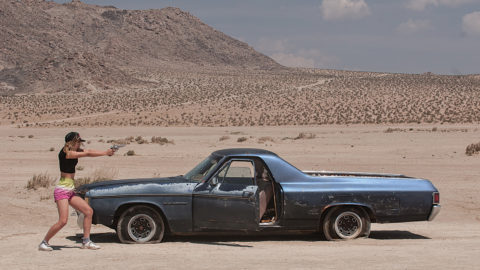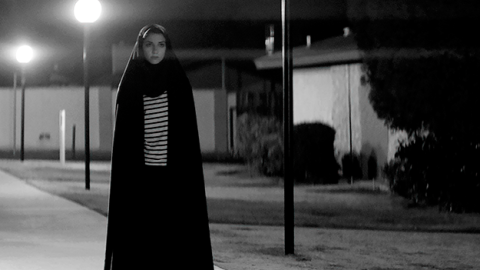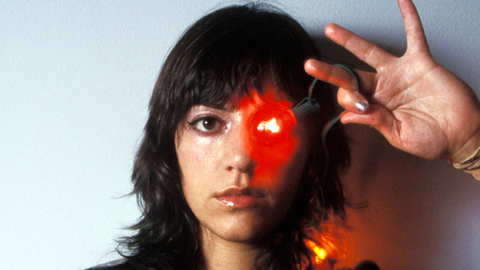Interview: Ana Lily Amirpour
The far side of the 2016 election is a poignant place from which to watch The Bad Batch. In Ana Lily Amirpour’s pop dystopia, tough customer Arlen (Suki Waterhouse) is released from prison into American desert borderlands occupied by violent exiles and daft cult members. Forget about a wall: Amirpour’s highly anticipated second feature obeys no limits, stretching Arlen’s travails across a canvas that’s big in every way—wide-screen wasteland panoramas, showboating action with needle-drop music cues, stars in cartoonish roles (Keanu Reeves, Jim Carrey, Jason Momoa), and a lanky against-type heroine who is all but holding a sign reading “badass.”
The Bad Batch, which opens June 23, received a decidedly mixed response at its Venice premiere, where some saw less than meets the eye. The Film Comment review by Farihah Zaman appears in our new May/June issue; in Venice last September, I chatted with Amirpour about the supersized film with which she follows her debut, A Girl Walks Home Alone at Night (2014).

When the film drops us into a dystopian landscape, it’s not immediately clear how the world, or Arlen, got to this point. Did you work out some kind of a backstory for her beyond what’s in the movie?
Yeah. Especially when you do this kind of fairytale adventure storytelling, it can quickly get two-dimensional if you don’t. It looks fantastical, it’s an extreme environment with these extreme stories. So if I know each and every one of [the characters], it helps me make the film—helps them be in it. So with Arlen, I saw this video of this girl, Cyntoia Brown. She was a teenage girl in Tennessee who killed this guy. She’s kind of white trash, she dropped out of high school, started going out with this drug dealer. Then he got her hooked on heroin, and he started sending her into these cheap hotel rooms off the freeway where she was hooking. And then she got all paranoid and shot a john and was convicted for murder at 16. So she was tried as a juvenile, and she was in prison for two years, turned 18—and then she got a life sentence.
At 18?
Yeah, and she’s still in prison. Her life is so fucked up and the story is fucked up. You could see it incrementally happening. It was like Reese Witherspoon’s character in Freeway. Tough, scrappy. That kind of girl. So it was that story, and I sent it to all the actresses. With Arlen, that was the starting point.
So you had already cast Suki by that point?
With my last film and this film, I like to write for the actor. So I had done that, but there was no actress that I was… she was the one. I decided that I wanted to find a new girl. Someone who excites me. Someone really different. I saw her tape, and I was like, “Oh my God.” And then she came in and read and I met her, and it was like, she was Arlen.
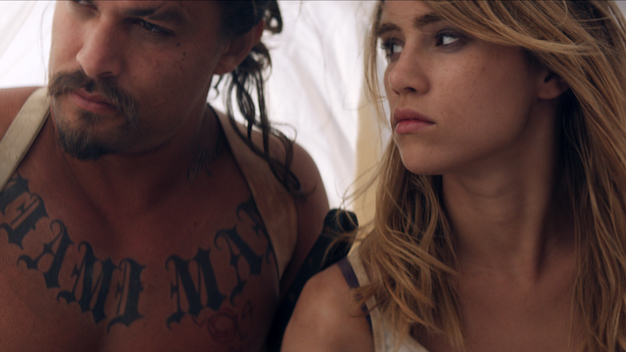
She doesn’t look like a musclebound action hero who’s mysteriously built up.
If you were on set, you would hear me saying, “She’s not dirty enough! She’s not sweaty enough!” I mean, that girl is a beautiful creature. I covered her in shit, I cut up her arms, and I did everything in my power to…
Muss her up?
Yeah. And she’s unstoppable.
The movie has a sweetness lurking underneath the toughness. It reminded me a little of certain ’80s movies, dystopias and otherwise.
Golden Child, for example. I grew up on movies from the ’80s and ’90s where there was this nostalgia and fun. Movies are fun to me, and I think at the same time, there’s definitely very real, dark, weird, fucked-up, crazy, chaotic things to put in the soup.
There’s more than a dash of Sergio Leone in the soup.
I love him. For me, making a film is this crazy, psychedelic, internal experience, and it takes a while to fully see what is going on. But I just remembered another movie: Romancing the Stone was one film I was watching and thinking about, more than any other. You know, that big action-adventure romance, with these two mismatched people.
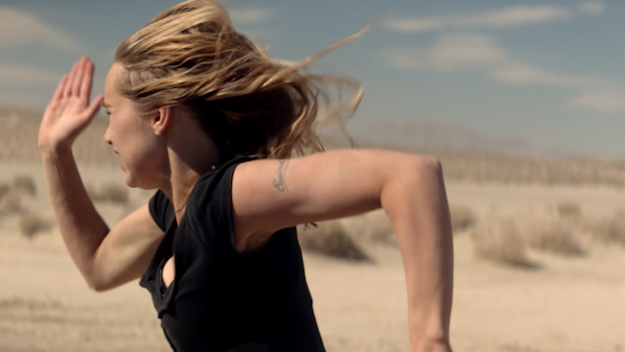
This landscape is exotic in a more dystopian sense…
It’s weird though, when people say “dystopia.” This is dystopia.
We’re living in it now, you mean?
Yeah. It’s like, always, in a way, a dystopia. Maybe we’re in the safe zone, we’re farther away? It’s bigger, so the distance is a little bit greater?
In the movie at least, the characters are stuck in a kind of no-man’s-land.
That part of the desert in California is called Slab City. There’s a very large community of people living off the grid that I spent a year going and visiting and hanging out with. And that’s where we shot. You drive three hours out of L.A. and in the desert. I cast a lot of the background [extras] there: that whole party scene when Keanu is doing that speech on the boombox, 90 percent of the crowd was Bombay Beach and Slab City locals.
Have you ever seen Below Sea Level, by Gianfranco Rosi? That covers the Slab City area.
I don’t know. I saw every documentary on the Salton Sea…
Did you camp out there?
Yeah, I went out there, made friends with them. That skate park is in Slab City. So the locals knew me, and there’s people that don’t have cell phones. For background extras, casting, it’s hard because you can’t shoot them an email on a cell phone. You have to go there and be like, “We’re shooting on this day.” There’s literally a flyer on a post. It’s like going back in a time machine. I think that’s the interesting thing about America: when you leave the big city where we’re in these lifeboats of thinking that that’s the way everyone is.



